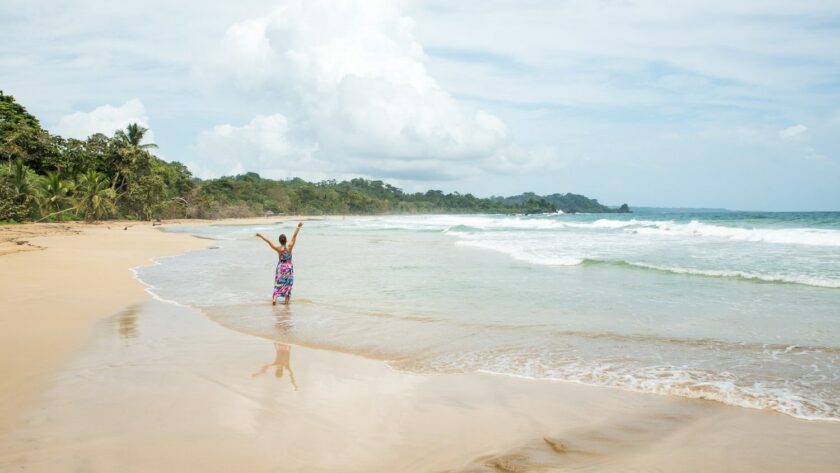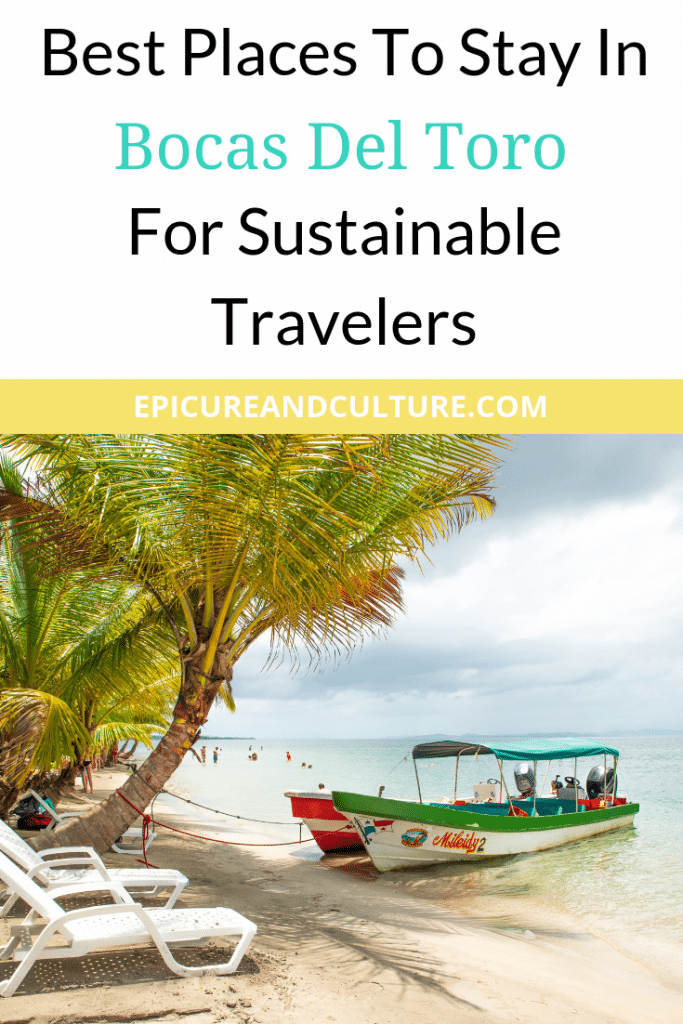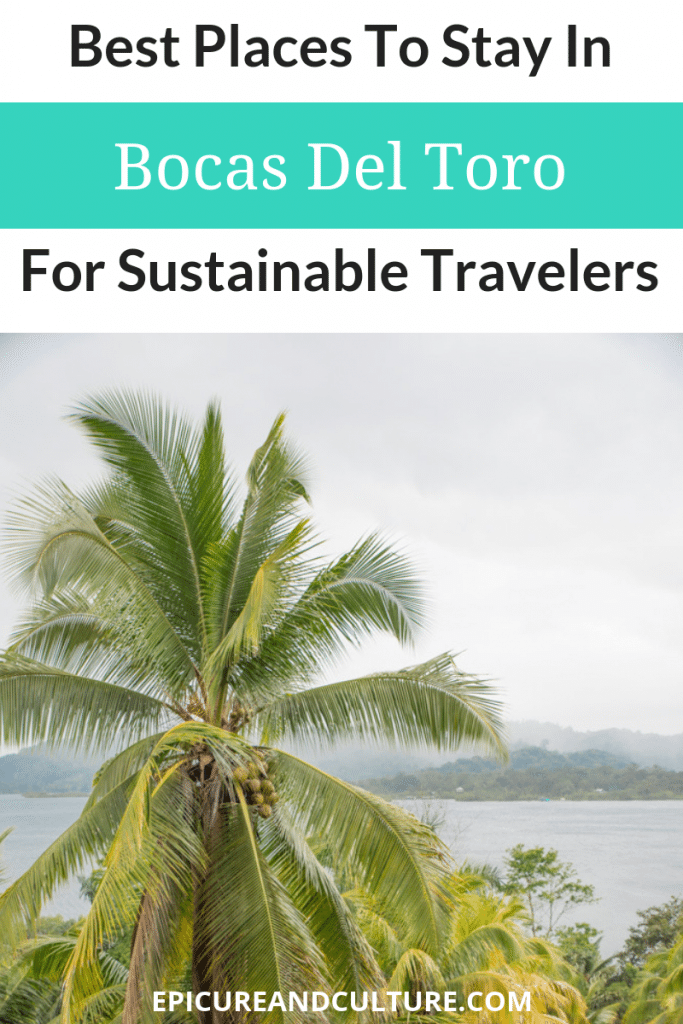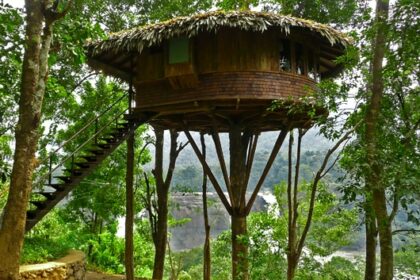By Jessica Festa, Epicure & Culture editor
This article highlights two of the best places to stay in Bocas del Toro, including La Loma Jungle Lodge & Chocolate Farm on Isla Bastimentos, and CocoVivo Panama on Isla de San Cristóbal.
When planning a trip to Panama, one spot you’ll want to make sure is on your itinerary is the Bocas del Toro Province.
From Bocas Town — where you’ll fly into Bocas del Toro “Isla Colón” International Airport — you can take small boat taxis to nine main islands, not to mention hundreds, possibly thousands, of tinier land plots poking out of the water.
After a few nights partying and shopping in Bocas Town, you’ll want to visit two islands in particular:
Isla Bastimentos and Isla de San Cristóbal.
Both offer stunning scenery and the chance to immerse yourself in nature, especially if you stay at the following two Bocas del Toro hotels.
Psst! Don’t forget to pin this post for later!
Panama Travel Video
Want to see what traveling Panama is really like?
My boyfriend, Andy, made a video from our two-week trip, exploring Bocas del Toro, Boquete, El Valle and Panama City.
Watch the fun above!
Where To Stay In Bocas del Toro: La Loma Jungle Lodge & Chocolate Farm
Approaching our Isla Bastimentos lodging, Andy and I know we’re in for a treat as soon as the doe-eyed pup — named Zorro — runs over to greet our boat.
The 20-minute boat ride from Bocas Town had been scenic; small islands and mangrove patches casting reflections on the mirror surface of the lagoon dotted with Bocas del Toro islands.
Little do I know that was just a visual appetizer; the precursor to stepping foot on the lush property of La Loma Jungle Lodge & Chocolate Farm.
As the skiff parks at the property’s private dock, we’re instructed to leave our luggage, as staff would be back to carry it up for us.
Usually I carry my own bags, though you’ll soon see why I eagerly agree at this particular Panama lodge.


As we walk to the main lodge to receive information on the property and welcome drinks — delicious jungle teas laced with lemongrass — wooden dock quickly transforms into dense forest dangling delicious produce, from pumpkins to jackfruit to bananas.
This main lodge sits at the base of a hill, and is where our group — two Americans (Andy and I), one woman from Belgium, a couple from the Caribbean and a family of four from England — will convene to eat our meals and plan our days.
It’s also where we can purchase handicrafts — like jewelry crafted from recycled tires —and natural insect repellents made by the indigenous Ngobe women who inhabit Isla Bastimentos.
This is one of numerous social good initiatives the La Loma resort partakes in.

In fact, one thing that is abundantly clear within just a few minutes of being at this incredible eco lodge in Panama:
La Loma is passionate about sustainability, particularly when it comes to the environment, with solar panels setup and a rainwater catchment system.
Moreover, they’re dedicated to empowering the local Bahia Honda community families.
Through their efforts, incredible projects have been completed, like the building of a local preschool, the creation of a playground crafted from recycled materials and the implemtnation of an afterschool sports and arts activities club.
While sipping our welcome drinks, we flip through coffee table books sharing stories of the local people, plants and wildlife.

When it’s time, Ariel, our Panama jungle lodge host, has us follow him to our treehouse cabins — but not before giving a few playful words of warning:
“‘La loma’ means ‘the hill’. You’ll soon understand why.”
I’ll admit the hike up the steep path to our hillside lodge isn’t easy; though I’ll say it’s honestly worth it for the view — not to mention the chance to be completely enveloped in secluded nature.
Instead of being built onto the landscape, La Loma hired locals to embed cabins into the hillside using local wood and working by hand.
The best part about the cabin:
Three of the walls are missing, meaning that instead of television — there’s no WiFi here —we’d be watching birds glide over the waters of Bocas del Toro, the faint outline of the Cordillera de Talamanca range in the distance.


Actually, there’s way more than this within our jungle vista.
There’s no way I could name the hundreds of plants literally visible from our bed, elephant ear leaves brushing against our balcony; though I can tell you I’m able to see an adorable sloth from my outdoor shower.
#GiveMeAllTheSloths

After settling in to our rustic luxury lodge in Panama, Andy and I go on our first local adventure to explore this beautifully raw landscape:
A one-hour hike along La Loma’s challenging “red trail,” one of two hike options onsite.


This trek takes us through La Loma’s cacao trees — where beans are grown to make their signature Panama chocolate farm treats — past the chicken coop and up a steep hill.
Dancing with trees and maneuvering around tiny red frogs and leaf cutter ants, we remain quiet and allow the sounds of the jungle to wrap us like an exotic blanket.
We aren’t in Manhattan anymore, that’s for sure.
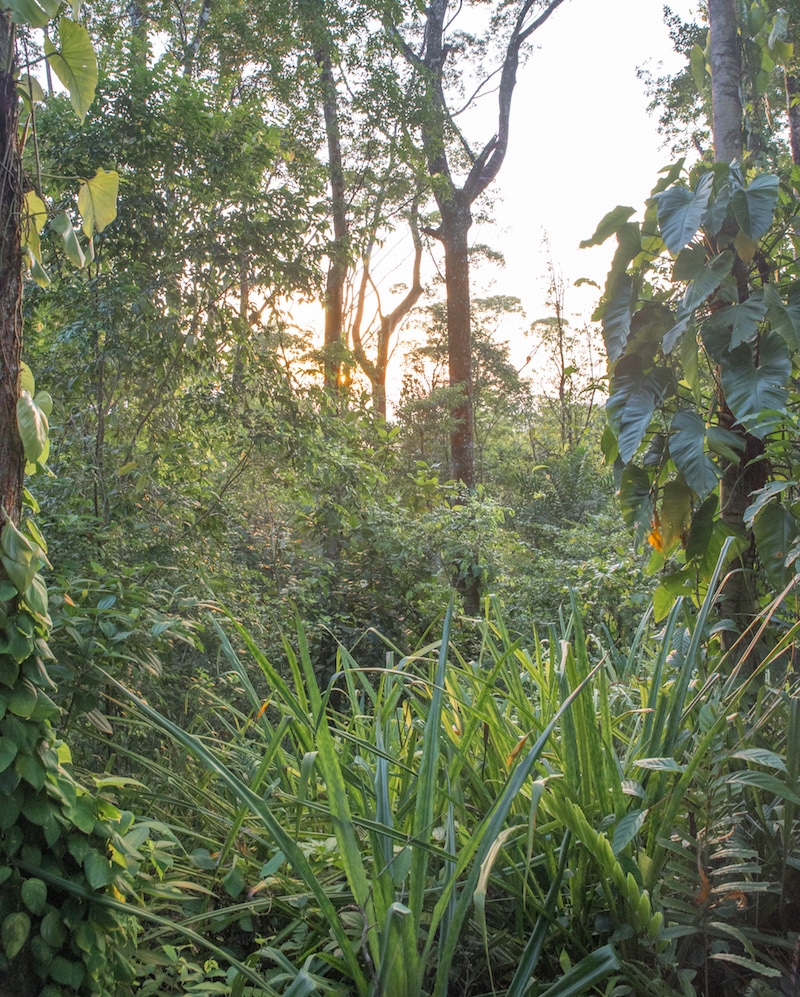
Passing creeks and bridges, scrambling up muddy paths, I’m truly at one with nature.
Afterward, it feels so good to peel off my sweaty clothes and wash off in the al fresco shower before dinner; my bare feet on stone ground with birds flying in to say hello.
By the time Andy and I make our way down to the main lodge for pre-dinner mojitos — made with Panamanian Abuelo rum — we’re ravenous from the calories burned.

Luckily, our evening meal is incredibly satisfying.
According to Ariel, about 60% of the ingredients in their homemade meals are grown onsite, from the pumpkin in the pumpkin soup to the coconut in the coconut rice underneath local blackjack fish.
For dessert, a decadent mound of chocolate cake laced with La Loma’s homegrown cacao allows us to truly savor the terroir of the island.
Oh, and I should mention La Loma Jungle Lodge is one of the top all inclusive hotels in Panama, with food, non-alcoholic drinks and a number of activities included at no extra charge.
That night, Andy and I take a bottle of sauvignon blanc up to our treehouse cabin to enjoy while listening to the whistles and chirps of the tree frogs and the gentle tapping of rain against the roof.
What’s funny is that when I’m trying to relax at home I play YouTube videos of “rain on a tin roof.” But at La Loma, I’m living it.
And while back in Manhattan it’s usually car horns and jackhammers that awaken me, the next morning our natural alarm is the howling of playful monkeys.

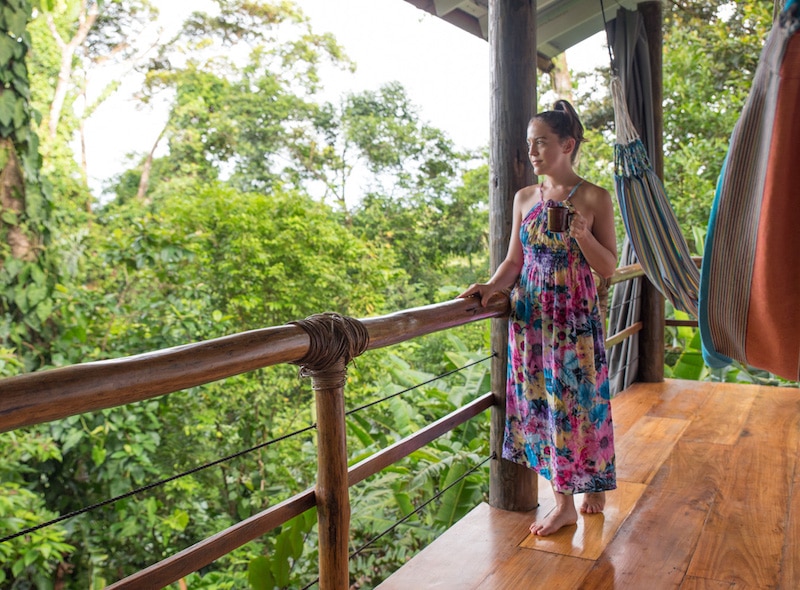
Opening the treehouse door at 7am, I’m greeted with a tray holding a thermos of coffee and homemade banana muffins outside on the porch; a pre-morning snack to the bountiful breakfast to come.
Down at the main cabin, my mug is refilled with more local java.
Sitting there, all of my senses are ignited through the mug warming my hands, the coffee aromas filling my nostrils and yellow-tailed pendula birds gliding from tree to tree and streaking the forest with their cheerful hues.
The resident cat, Minchi, lays next me at the table to lap up a patch of sun, while hummingbirds savor the nectar of the bright hibiscus flowers.

That’s when I realize just how hungry I am.
Not a problem, as there’s plenty of delicious local food to go around:
Fresh tropical fruits, homemade granola laced with cacao nibs, Panamanian fry bread and farm fresh scrambled eggs enhanced with a homemade pepper sauce.
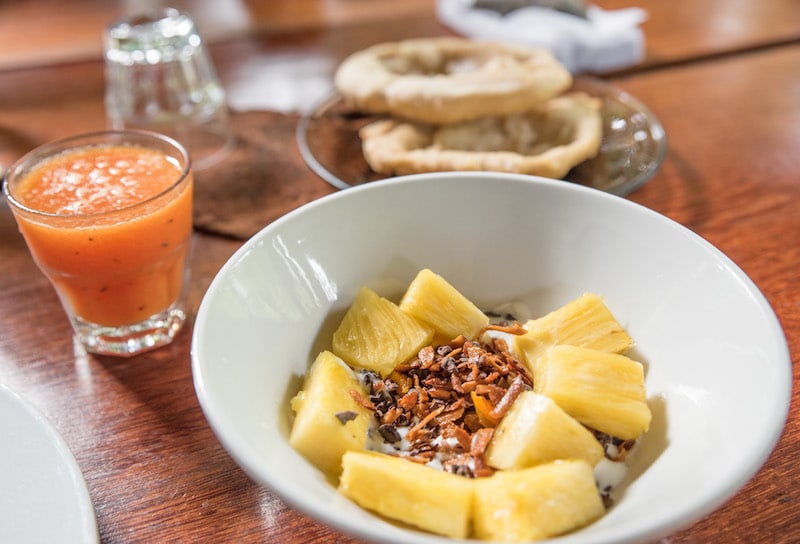
The calories are needed, as the day brings a truly energetic Panama adventure:
Hiking 45 minutes from Red Frog Beach, one of the larger Panama resorts, to Polo Beach on the other side of the island.
While an extremely scenic walk — enhanced by the warm Caribbean Sea lapping up at our ankles — there are some sections where we must carefully maneuver over patches of jagged rock and thick fallen trees.
At times, the scenery is otherworldly, with jagged cliffside and lush uninhabited islands creating contrast to the idyllic scene.
At one point it begins to pour, though we wait it out in a small lean-to where a local man sleeps.
He waves to us and smiles as we run inside with our belongings, and I hand him a bag of maní (peanuts) from my packed lunch to thank him for helping us stay dry.
Within an hour, the showers have passed.



Before they’ve fully stopped, Andy and I run and dive into the warm Caribbean waters.
Usually I’m more of a land creature, but on this day you can’t get me out until the minute it’s time to go.
By the time we arrive back to La Loma it’s raining again, though this isn’t a bad thing. It only adds to the relaxing, WiFi-free ambiance.
In hammocks with glasses of wine, we again decide against talking or listening to music.
Instead, we let the rain, the rustling leaves and the wildlife lull us into a state of utter relaxation before dinner.

Speaking of evening meals, this one is filled with delights:
A pumpkin soup paired with taro for dipping, blackjack fish dressed in curry and a chocolate trifecta featuring a house-made truffle, cacao nib shortbread and hot chocolate spiked with local rum.
Afterward, we’re in for another treat; this one of the non-edible variety:
A night walk.
One of La Loma’s personalities we meet is Chappey, an energetic man in charge of everything from tending the plants to building the cabins to filleting the fish dinner.
He and Ariel guide us around the Panama rainforest resort property with flashlights, pointing out animals, insects and plants I undoubtedly would have never spotted on my own.
First there are the caimans, floating peacefully, or so it seems.
“This is when they hunt,” explains Ariel. “When a sloth comes down to go to the bathroom, they’ll get him.”
We also savor sugarcane from Chappey’s onsite home, cotton candy-like guanábana fruit and bitter green leaves.

Chappey points out enormous grasshoppers that look like aliens, giant spiders, tiny frogs, cacao pods and a plant that — if the juice gets on you — can blister your skin.
Not surprisingly, I learn Chappey’s grandmother was a bush doctor, which explains his clear devotion to nature and passion for plant knowledge.
Actually, when one woman arrives to the lodge with a sprained ankle, Chappey brings her a bowl of yuca shavings, places them on a towel and wraps it around her ankle as an antidote.
I seriously wish I could bring him to New York to help me forage in Central Park for remedies!
That night Andy and I go to bed early, tired from the day’s adventures, buzzed from the day’s cocktails and excited for the next morning to head out with a local named Roger, whose father discovered a giant bat cave within the Isla Bastimentos National Marine Park.
Roger picks us up from La Loma in his skiff boat, and takes us on a tour of the local mangroves.

While mangrove wood used to be a popular choice for building houses, now the mangroves are protected.
It’s easy to see their importance, as we spot a number of wildlife species, from crabs to caimans to capuchin monkeys to — my favorite — a three-toed sloth so close we can clearly see her smiling face as she scratches her armpits.
The highlight though is donning giant rubber boots and hiking 25 minutes through the national park to the Nivida Bat Cave.


Before entering, Roger hands us helmets and head lamps.
“Look at the wall before you touch it. There may be giant spiders.”
And giant spiders there are…
…and bats, whizzing by our ears like flying NASCAR drivers.
A river flows through the cave, and I struggle to manage my footing on the invisible uneven ground in the dark space.
Wowever, as soon as I look up and see what looks like 101 bats smiling devilishly at me, I realize this will probably be the most unique of all the Panama vacation spots we visit.

Our group walks through the cave for about 20 minutes, the water getting higher and higher.
Finally, we stop at a large rock shelf.
“Leave everything here,” instructs Roger. “The water gets so deep that at points you’ll need to swim.”
I try really hard to not let my shoulders go underwater; desperately attempting to stay on my feet so I can use my hands to keep the spiders away.
In my mind, these spiders are like fish; expert swimmers with fins and gills who probably know how to hop out of the water and onto my body.
But as the chilly water inchs closer and closer to my hairline, and the bats continue to zoom by within millimeters of my ears, I lift my feet off the ground and just give in to the experience.
Finally we reach a dry patch, with a pool on the other side. Above the pool is a rocky outcropping you can climb to “cliff jump.”
“Just look out for the stalactites,” warns Roger. “You don’t want to hit your head.”
Obviously, Andy is the first one in. And the second. And the third.
I flinch, praying I won’t need to tell his parents that he cracked his head open in a Panamanian bat cave.
But each time, he pops up smiling.
It’s one of the most fun and unique adventures I’d had in a long time.
Back at La Loma, we end our stay in the perfect way — with another jungle farm-inspired meal.
On our plates:
Seasoned lentils served with fresh jungle-sourced salad and local cheese.
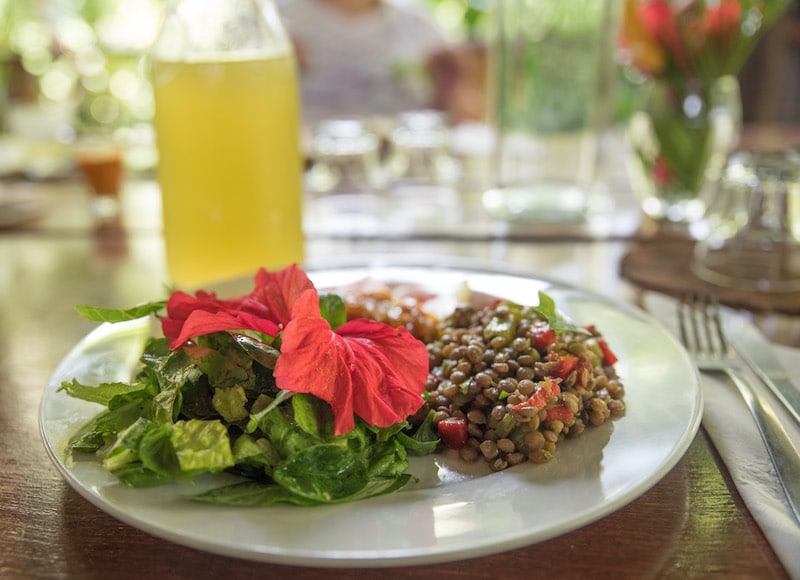
The final bite is bittersweet — literally — as Ariel brings us some guava shortbreads with La Loma’s signature chocolate.
This luxury jungle lodge truly immersed us in nature, and we’re really sad for our Bocas del Toro all inclusive stay to come to an end.
Luckily, we’re headed to another exciting Panana jungle lodge.
Bocas del Toro Eco Lodge: CocoVivo Panama
La Loma’s fearless Captain Kelly drops us off in Bocas Town, where we’re picked up by a local boat taxi driver named Choy.
Choy drives us about 25 minutes across the sparkling lagoon to our next Bocas del Toro destination:
Isla San Cristobal.

Like La Loma, CocoVivo focuses on sustainability and social good; though while La Loma offers an upscale experience, CocoVivo is a rustic eco resort that can accommodate a more budget-conscious crowd.
And, like La Loma, Carmen and Lazare — the couple who owns CocoVivo — have pets we can play with; specifically three loveable dogs named Captain, Osa and Nanoosh.
In terms of rooms, the property features five diverse cabins — all crafted with sustainability in mind — that sit along a lush stone path.
Solar panels provide electricity, so it’s vital to be mindful when charging gadgets and using the fan.
Moreover, collected rainwater comes out of their tap, though for drinking they import potable water from recyclable bottles.



Andy and I have the most secluded cabin at the very end of the path; a simple but clean wooden room constructured right into the mangroves.
Actually, while using our outdoor shower we watch crabs crawl up the mangrove roots, while our outdoor toilet — only for peeing — goes straight into the lagoon water.

At the end of our bed, two doors open onto a private hammock-adorned patio, offering gorgeous views of Volcan Baru — Panama’s highest point — and the mainland.
While having our room embedded into the landscape means we can only use biodigradable soaps, a breahttaking house on the hillside has a shared western toilet and indoor shower — not to mention a second floor yoga room offering the best Bocas del Toro views from the property.
Andy and I spend a lot of time in the hammock on our private waterfront deck, though that’s far from the only onsite experience offered at CocoVivo.

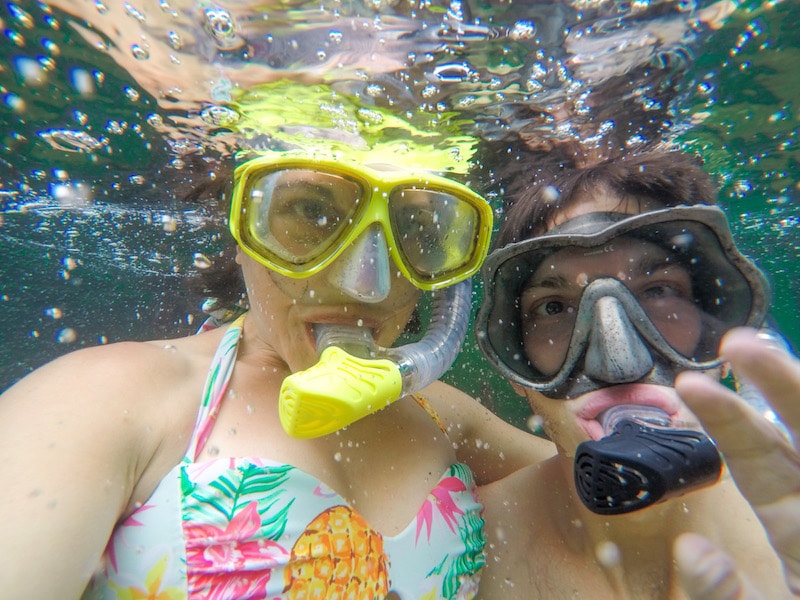
We have one full day at CocoVivo, spending most of it on their main dock.
Here, clear waters showcase healthy coral reefs and tropical fish.
We make use of the free snorkel gear, and also view the lagoon from above while swaying in the breeze on wooden swings from the edge of the dock.
At one point, Andy dares me to jump from the second floor diving board — a wooden plank from which you can plummet straight into the water without ever feeling the bottom.
I accept, gulping as I grip the wooden pole I must climb to reach the board; sticking my toes into small grooves to move up.
Standing over the lagoon with just a flimpsy plank beneath me makes my palms sweat; though once I’m flying through the air — and then crashing into the water — I’m all smiles.
What’s incredible about this water isn’t just the vibrant corals and the dolphins, but the fact that when it’s dark out it becomes bioluminescent.
Now, a few years ago I kayaked in the bioluminescent waters of Puerto Rico, which turn neon green to the touch; however, in this Bocas del Toro bioluminescent bay there’s more of a sparkler effect.
As in, when you touch the water, it looks like glitter is shooting out of your fingertips.

Our aquatic adventures are interspersed with exploring the onsite hiking trails to see Isla San Cristobal’s waterfalls, accompanied by all three of the resident pups.
Hiking and swimming work up an appetite, and by lunch Andy and I are ready to visit our soon-to-be favorite lunch place, Los Amigo’s Fried Chicken.
To get there, we grab the free-to-use paddleboards and head across the lagoon to the mainland to this open-air Bocas del Toro eatery, where only one thing is on the menu:
Fried chicken with fries and coleslaw.


For cocktails, a sparse bar crafts mixed well drinks. Sipping ginger ale and local rum, we sit outside and watch daily local life in Panama.
The thing with CocoVivo is it’s not just a hotel where you stay to yourself and never really know your hosts.
Instead, you’ll get to know Carmen and Lazare as you hangout on the dock and talk over meals and beverages.
Carmen and Lazaro do much of the cooking, with food ranging from just-caught-that-day barracuda to deliciously seasoned beef skewers served with homemade mayonnaise.
Both breakfast and lunch include multiple courses, like a smoothie and homemade granola with breakfast and an appetizer and dessert with dinner.
The food and the conversation are equally inspiring.

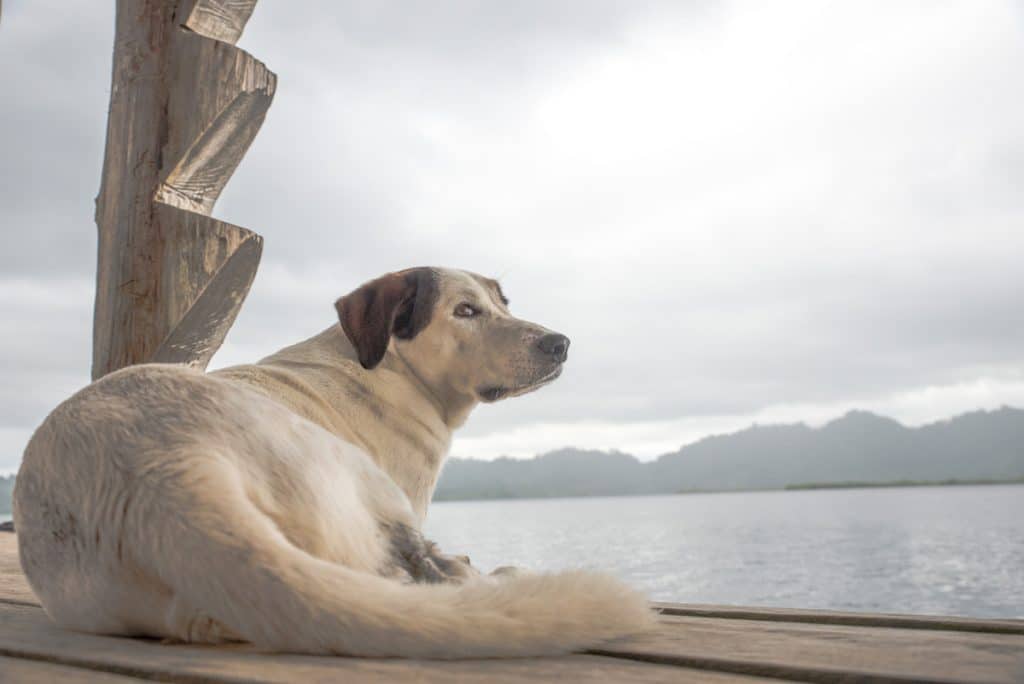
When searching for the best places to stay in Bocas del Toro, realize your options go well beyond a simple hotel room.
Whether you’re looking for a more upscale all inclusive jungle accommodation like La Loma, or something more budget-friendly on the water at CocoVivo, you’ll get an immersive eco-friendly experience that allows you to truly unwind in paradise.
What are your favorite Bocas del Toro hotels? Please share in the comments below!
Enjoyed this post? Pin it!
Logistics:
Electronics Warning: MacBook Pro problems! Make sure to keep your electronics, namely your laptops, in a sealed bag, as high humidity in places like Bocas del Toro can ruin them.
Additionally, you can purchase a dry bag for when your gadgets are not in use, like this one.
Panama Transfers: Hello Panama is a top-rated company in Panama who do many of the popular transfers. We used them to go from Bocas Town to Boquete for $30.
Bocas Taxi Boat Recommendation: If you need a boat ride between Bocas Town and another Bocas island, contact Choy at +507 6711 8878.
La Loma Jungle Lodge & Chocolate Farm Loging & Rates: La Loma has four cabins, including three treetop cabins ($130/person/night) and one rock pool cabin ($120/person/night) that requires less of a climb to reach. There is a single person supplement of 50%. Their rates include lodging, three delicious meals each day, one pre-breakfast meal and certain tours. Their rates also include transfers to and from Bocas Town. Rooms have high-powered ceiling fans, insect repellent (spray and coils), and mosquito netting around the beds.
CocoVivo Rates: Rooms range from $55-$100 per night, depending which cabin you choose. There is Wi-Fi and room fans, though note they typically run out of electricity after dark (which is replenished during the day). Meals are an additional cost of $30 per person, per day, including a multi-course breakfast and multi-course dinner.
Booking CocoVivo: CocoVivo lists their rooms on Airbnb. If you’re a new Airbnb user, click here to create your account and receive $40 off your first booking!
Bocas del Toro Packing List: A few must-pack items when visiting Bocas del Toro include the following:
- A Vigilant personal safety alarm or safety whistle (I’m never without this!)
- Clever Travel Companion pickpocket-proof garments (I’m never without this!)
- Speakeasy Supply Co hidden-pocket scarves (I’m never without this!)
- A compact raincoat
- A waterproof backpack
- All-natural insect repellent
- Re-useable eco-friendly water bottle
- ArcherOG biodegradable wipes
Bocas del Toro Tours:
Jessica Festa
Latest posts by Jessica Festa (see all)
- A Culturally-Immersive Adventure In Mongolia’s Altai Mountains - Jul 8, 2023
- This Recipe Sharing Platform Supports Women In The Culinary Industry (Labneh Recipe Included!) - Nov 5, 2020
- Hiking The Mohare Danda Community Eco-Trek In Nepal - Jun 3, 2020
- 6 Important Questions For Choosing A Responsible Yoga Retreat - May 18, 2020
- How To Create & Grow A Profitable Blogging Business (Ethically) - Jan 18, 2020

